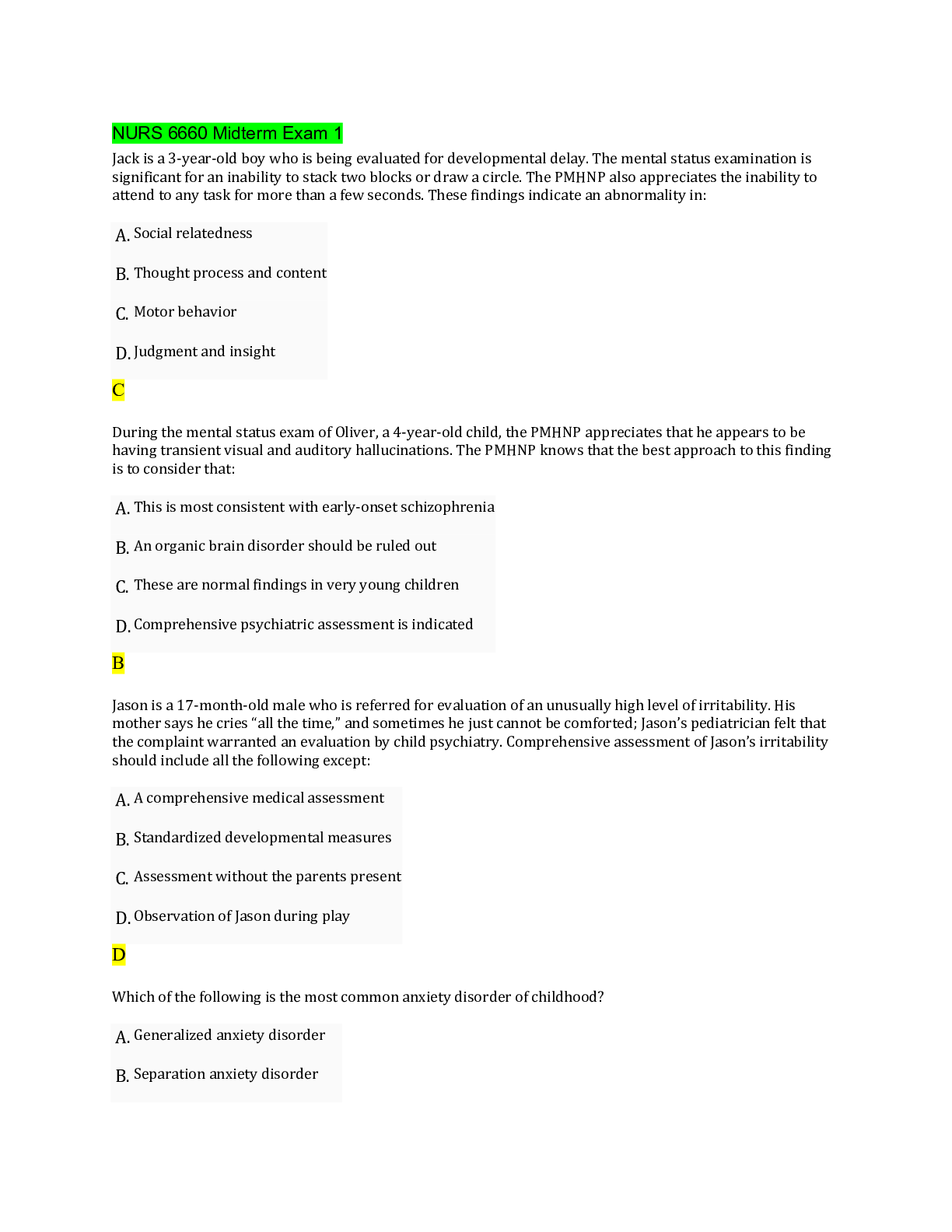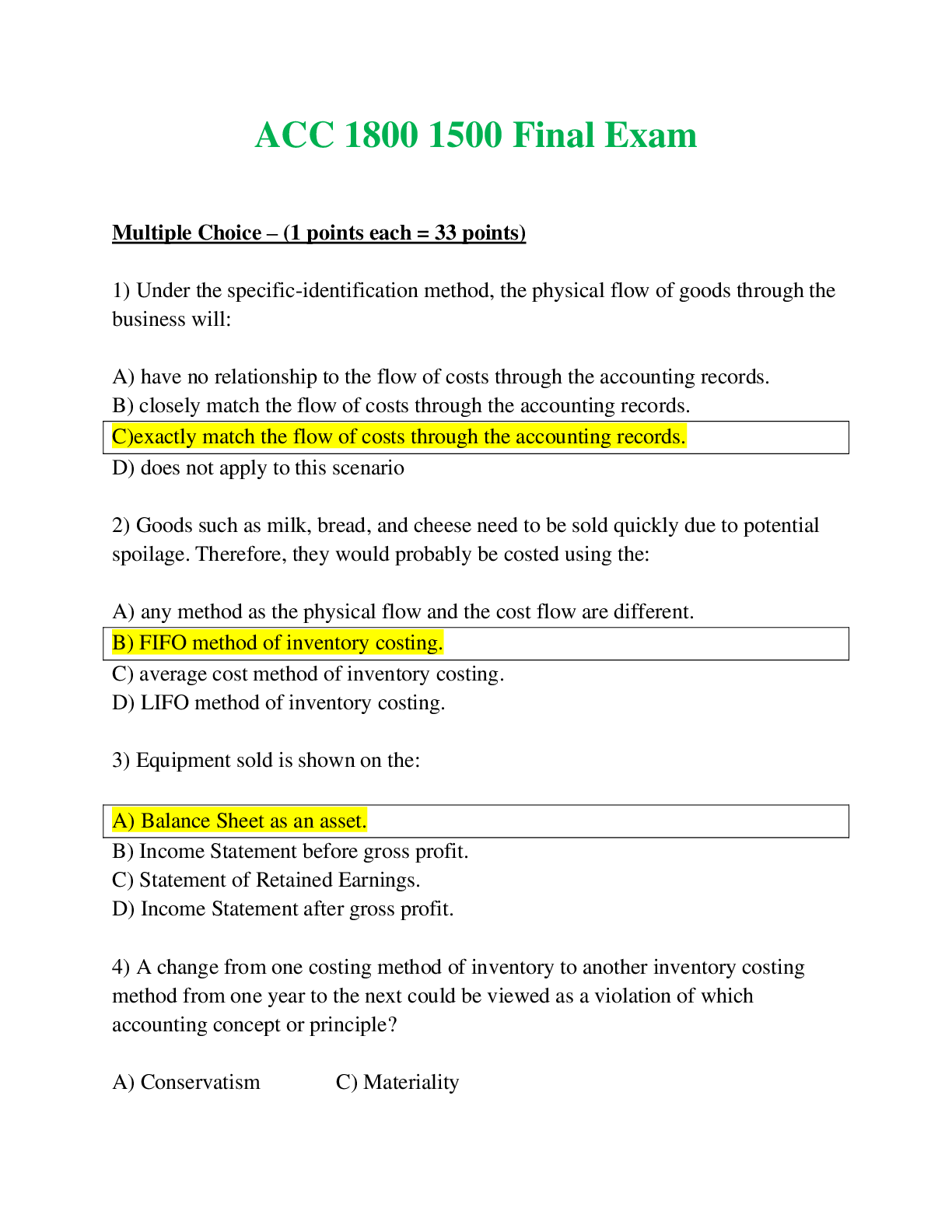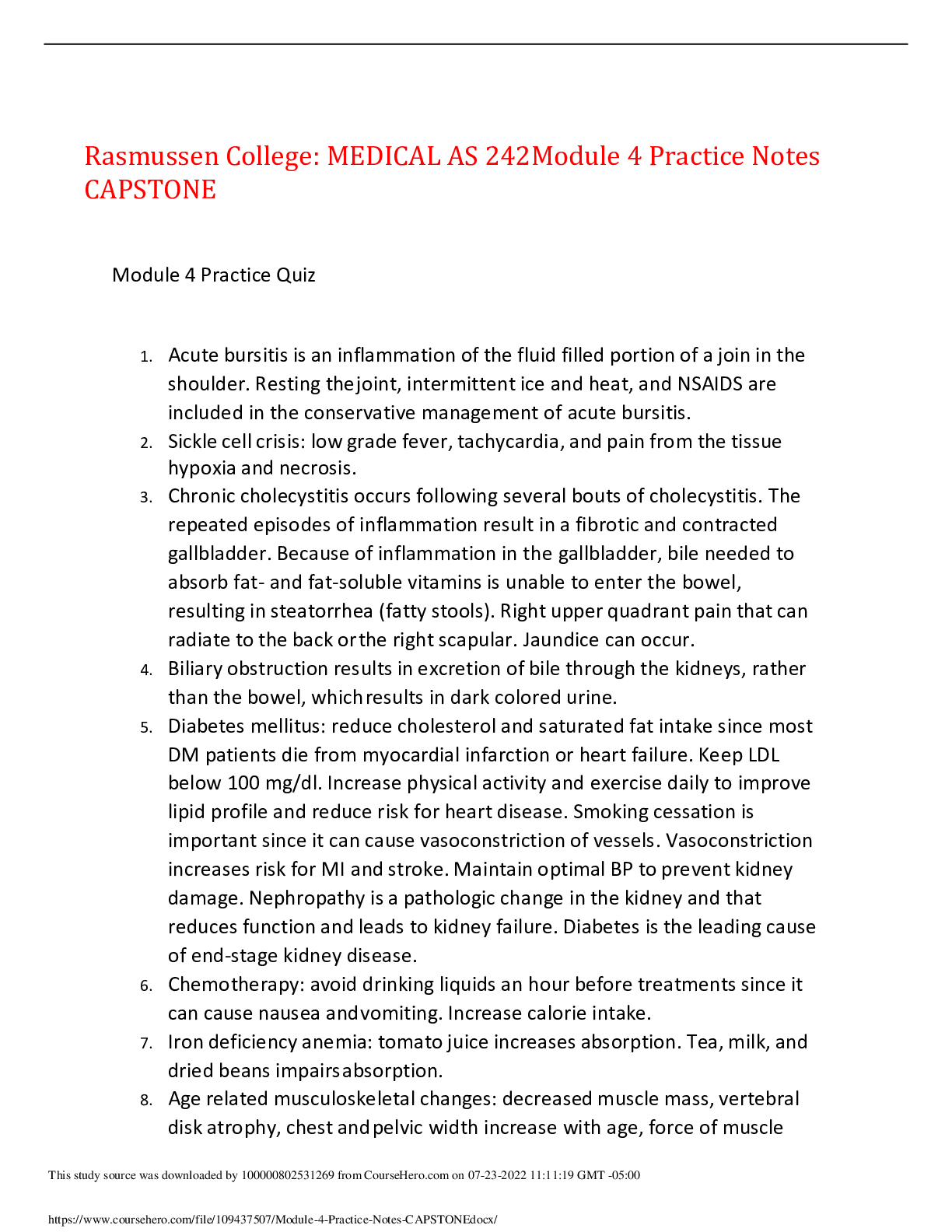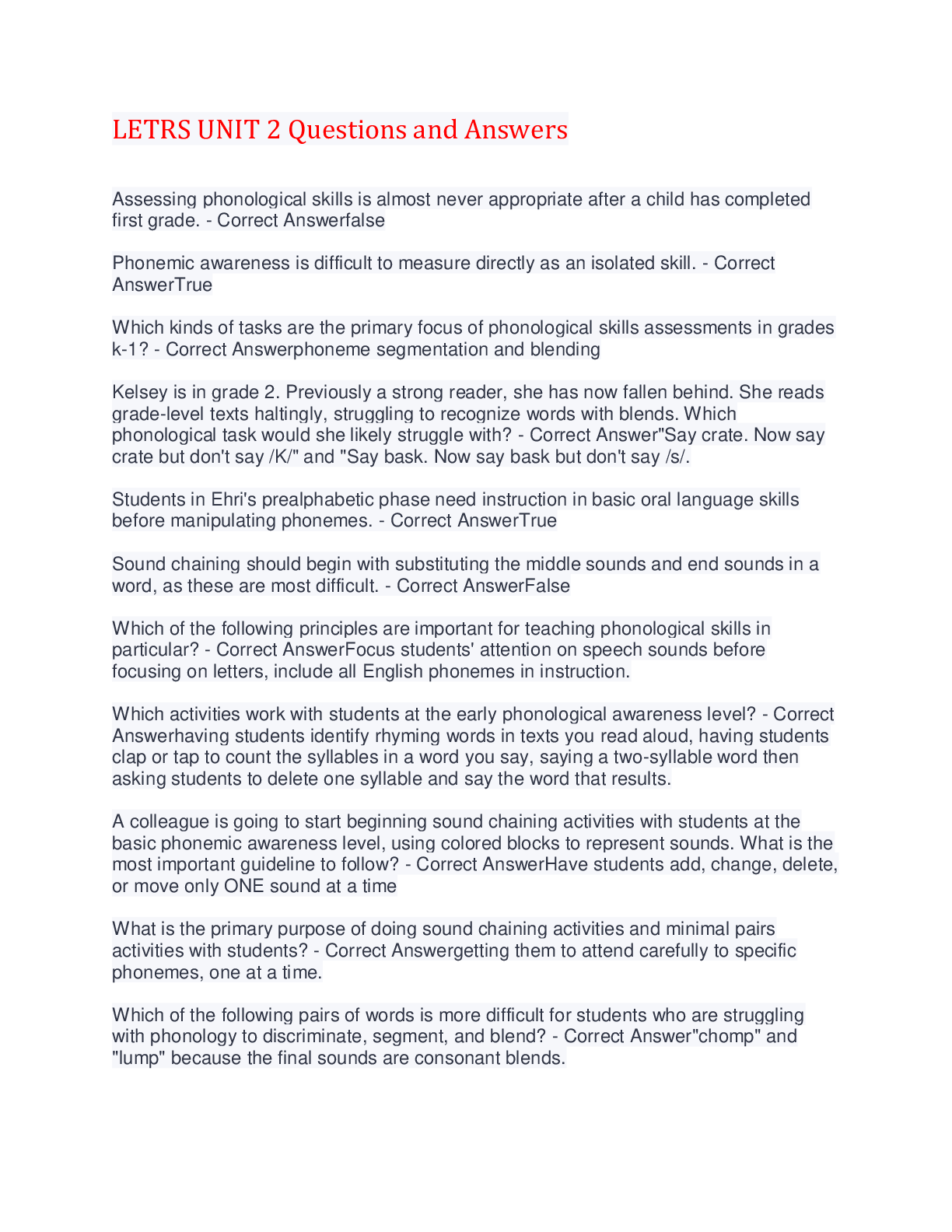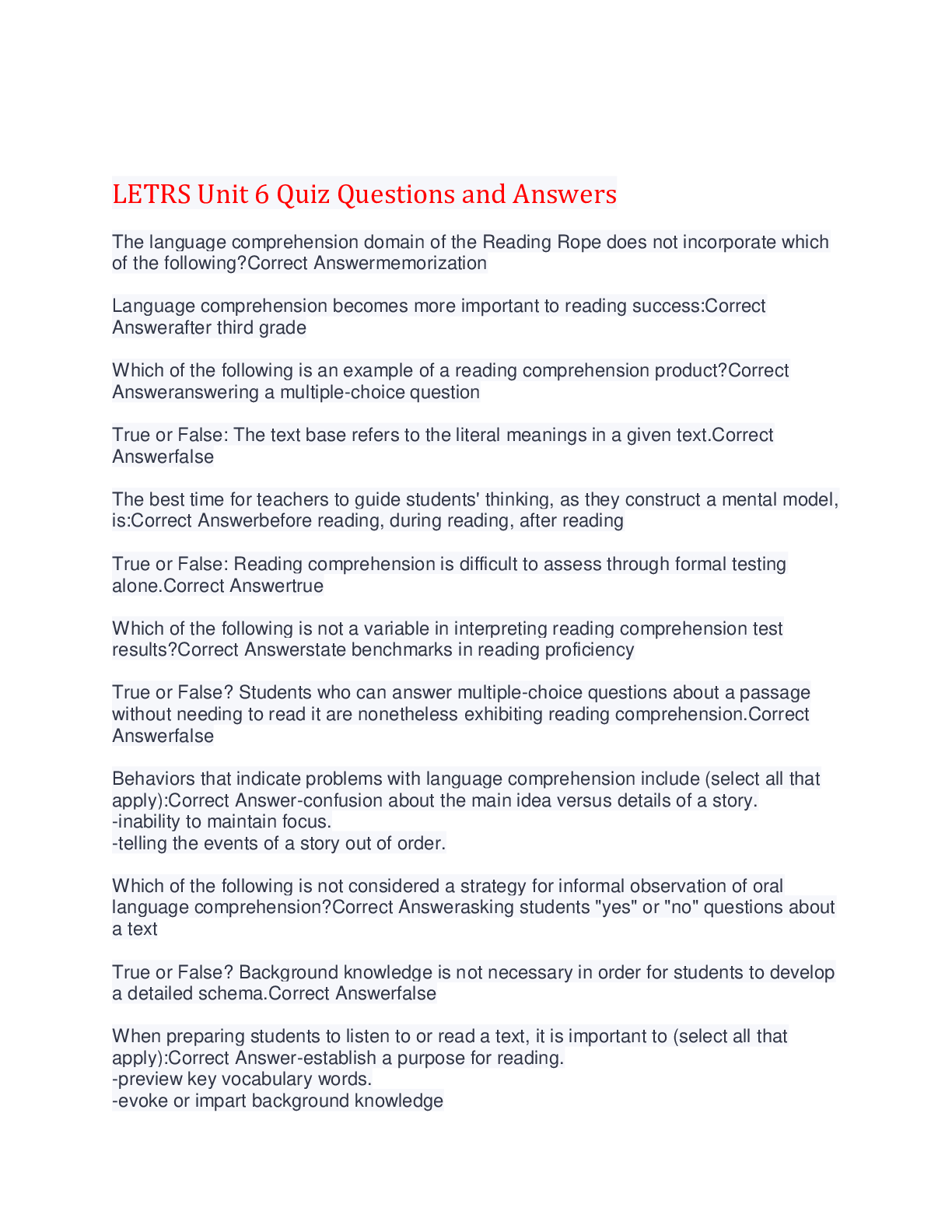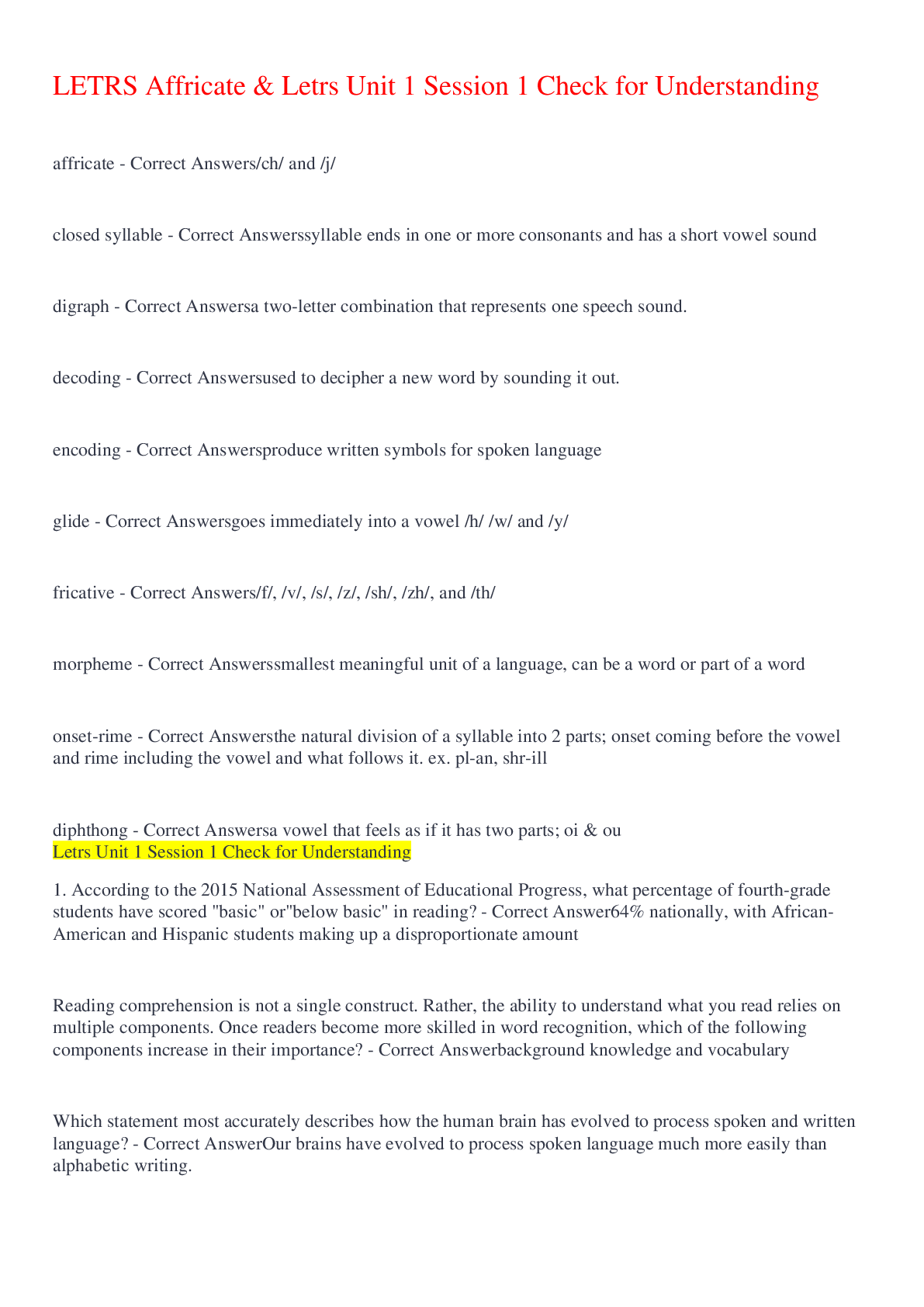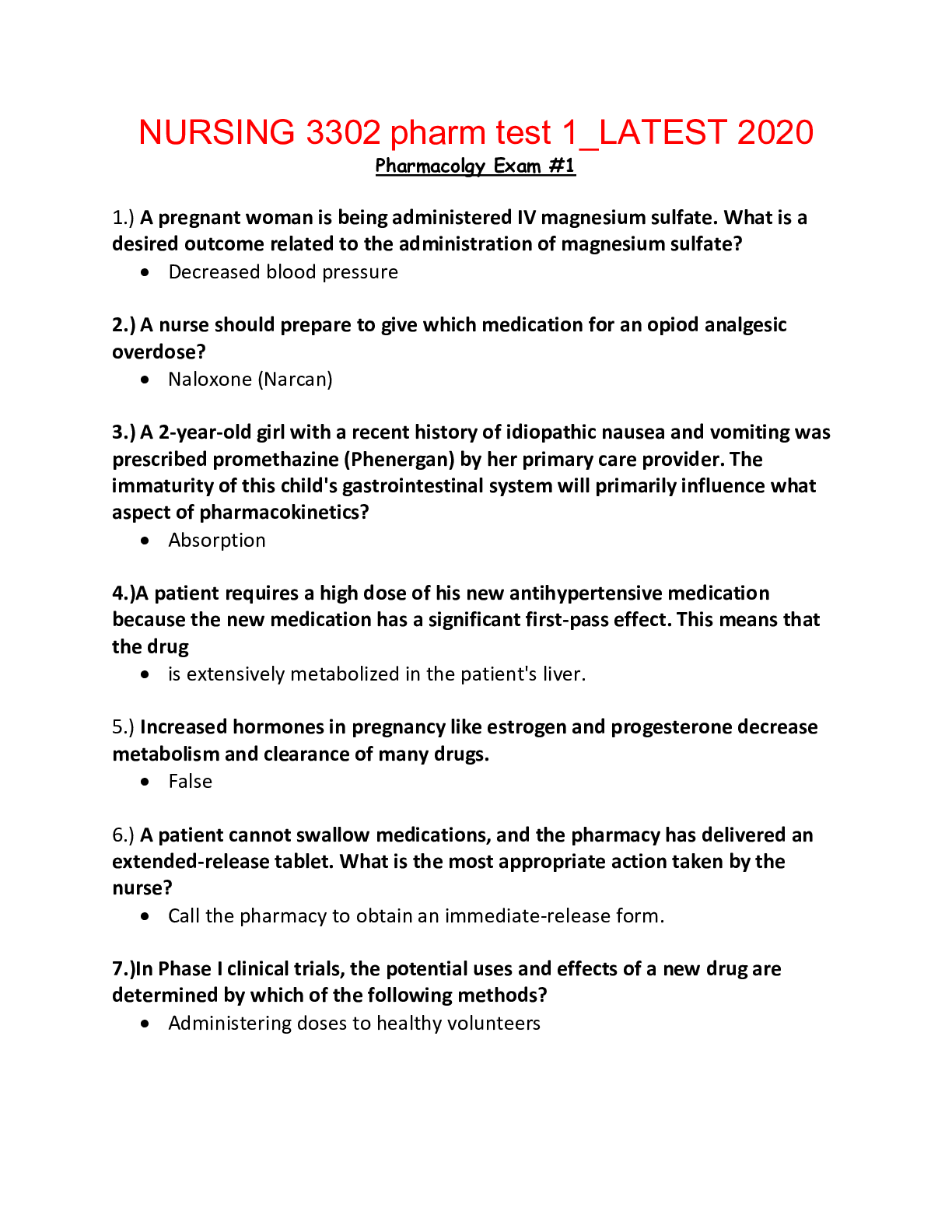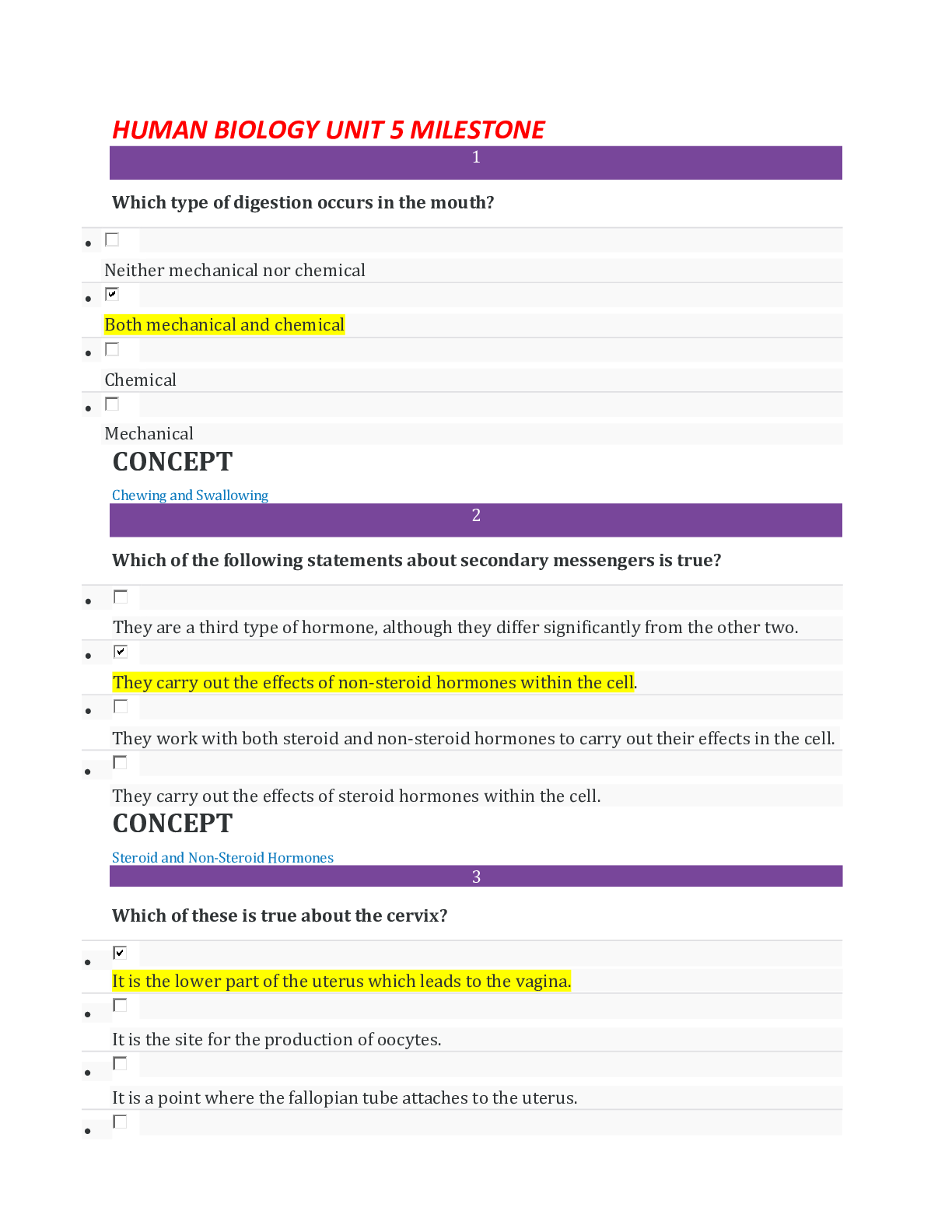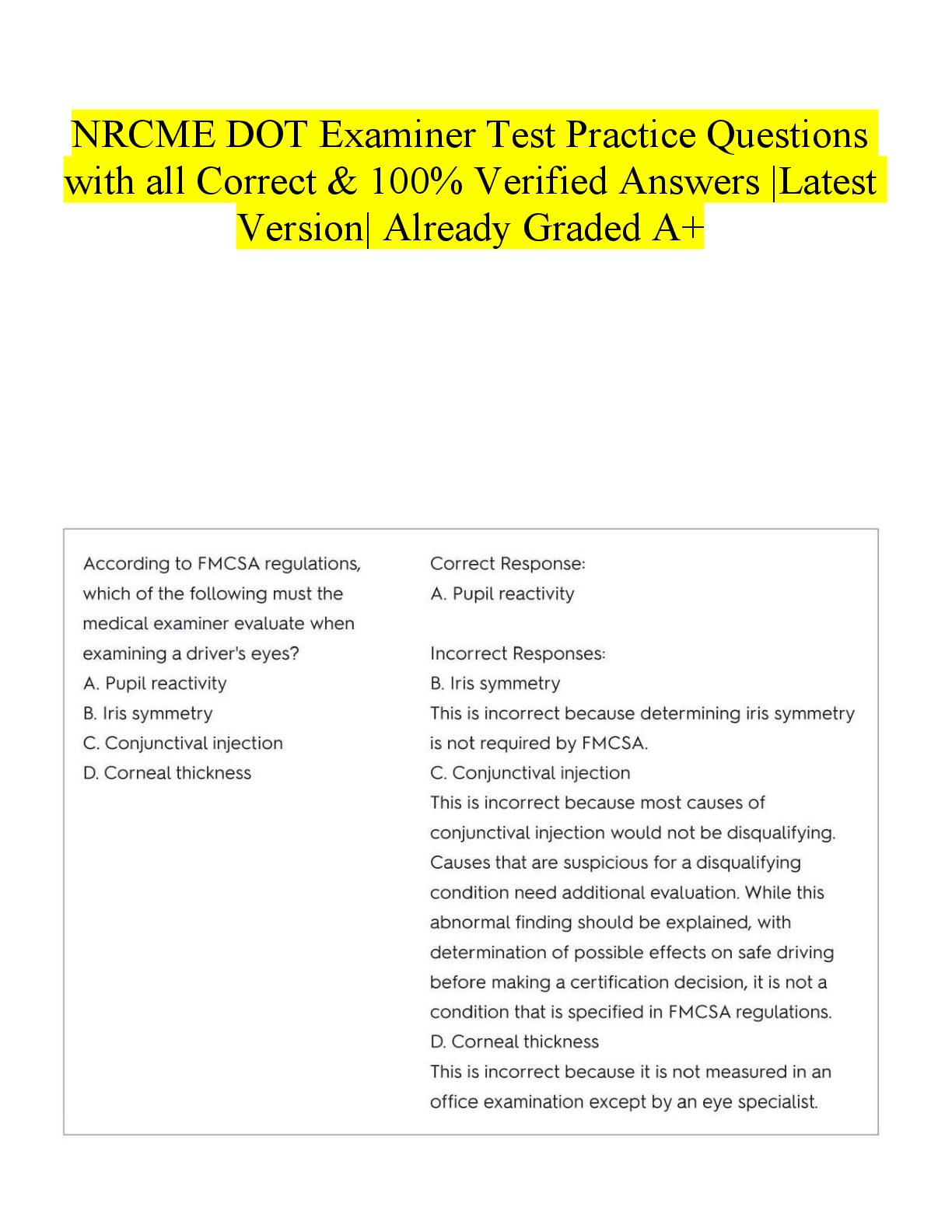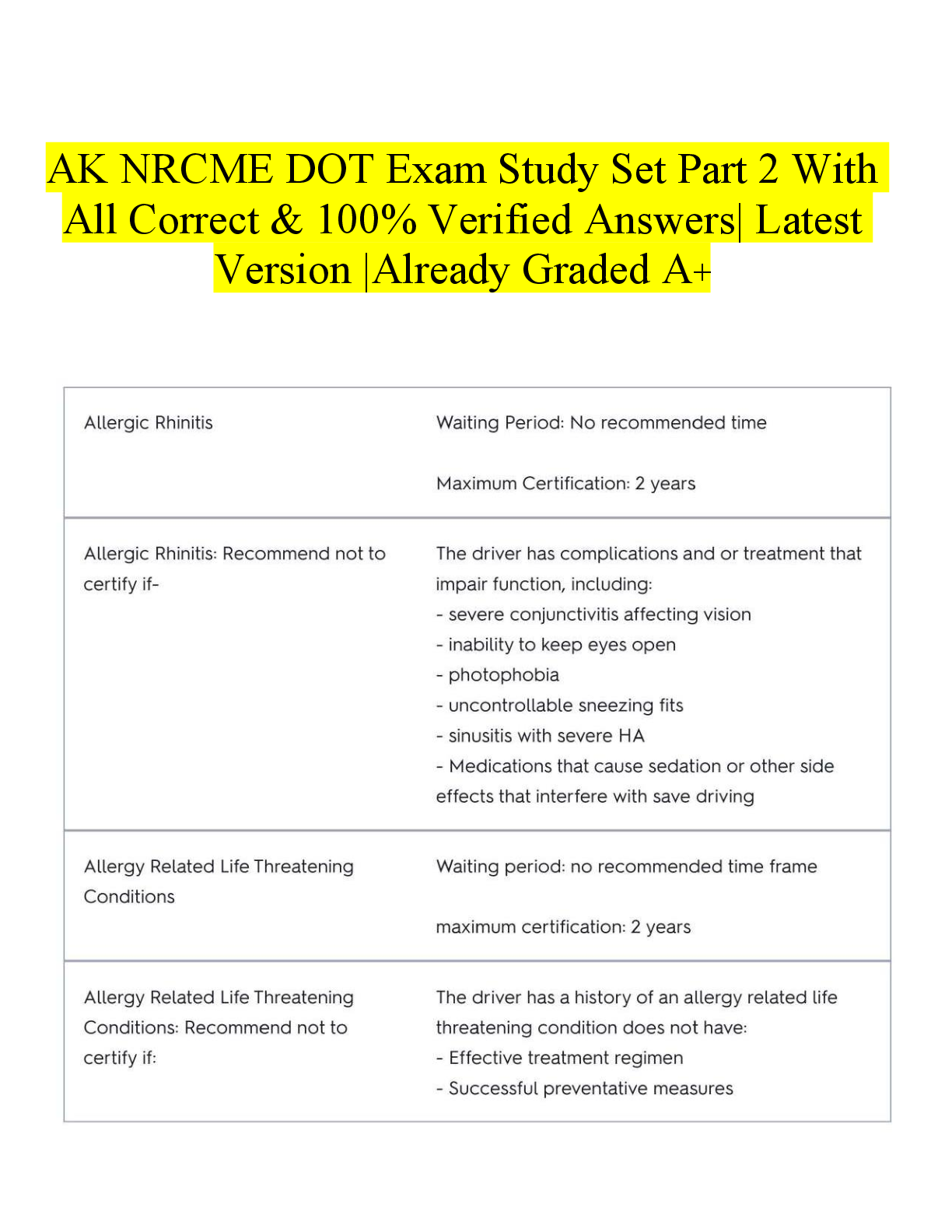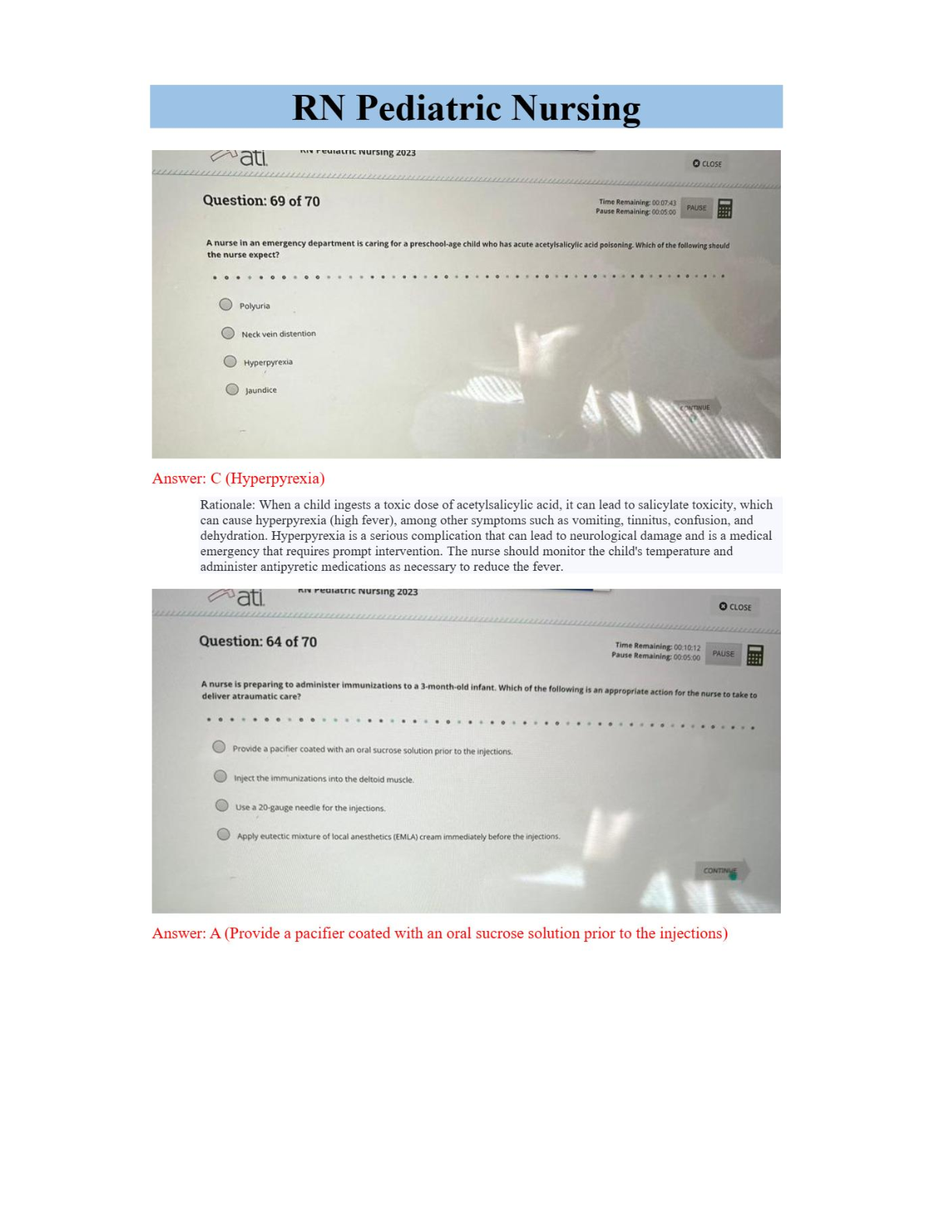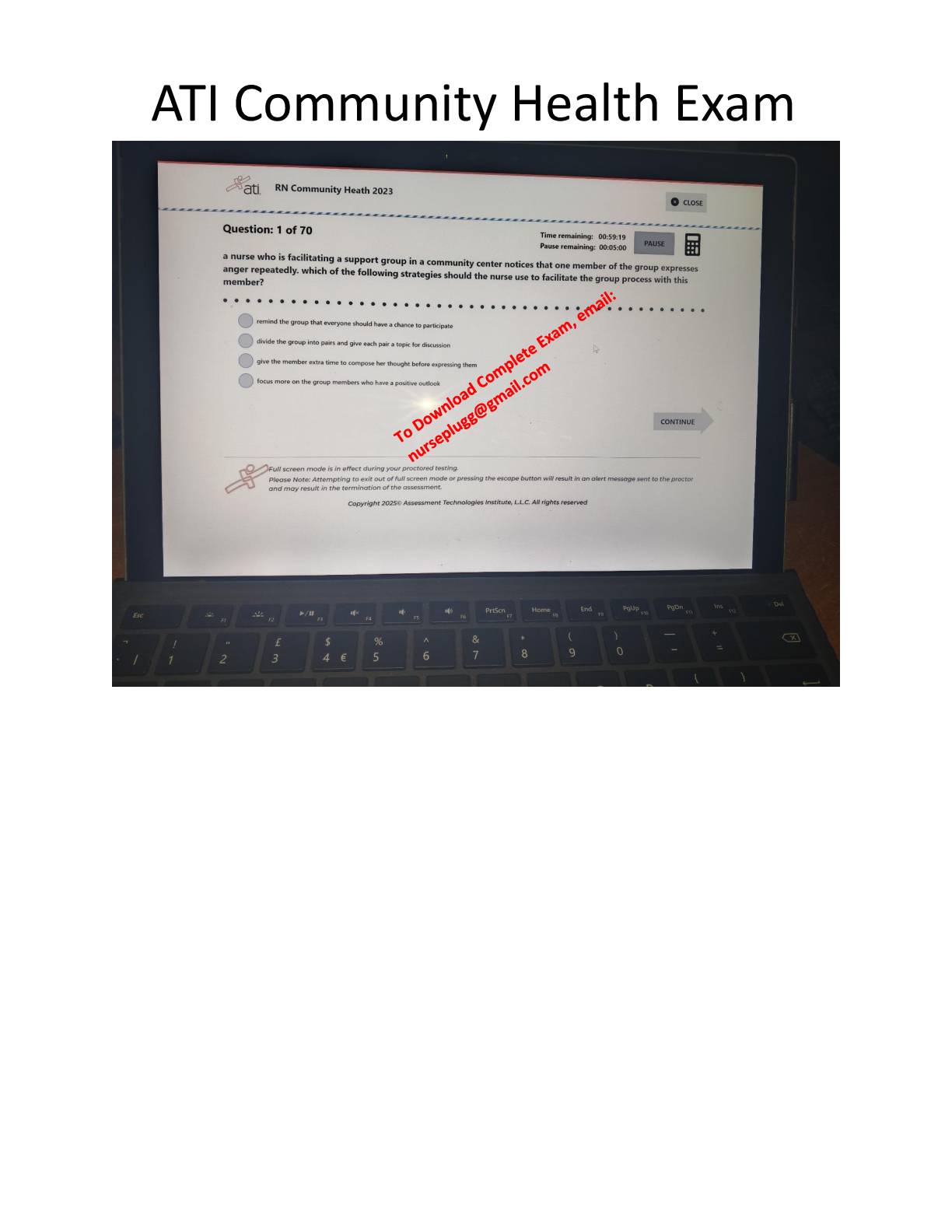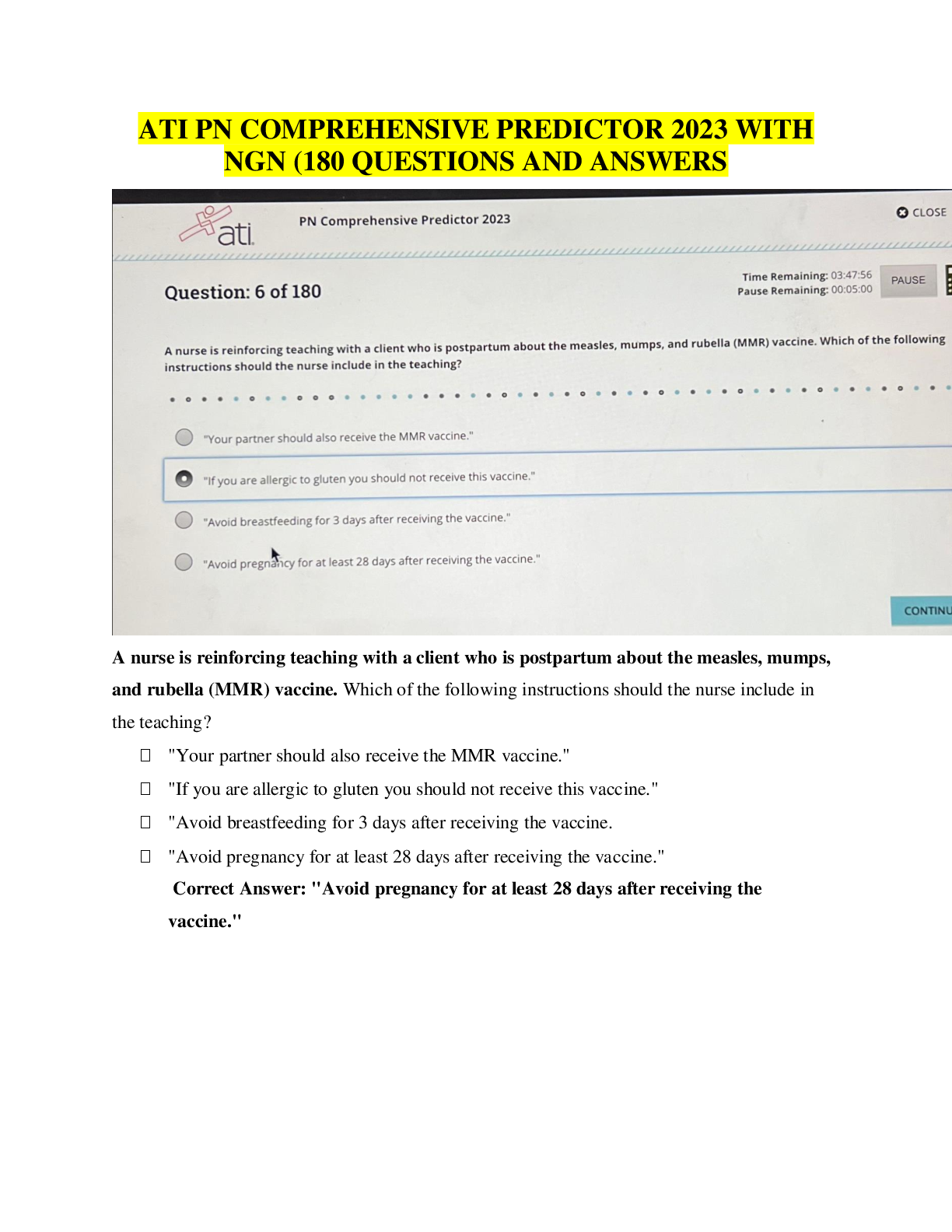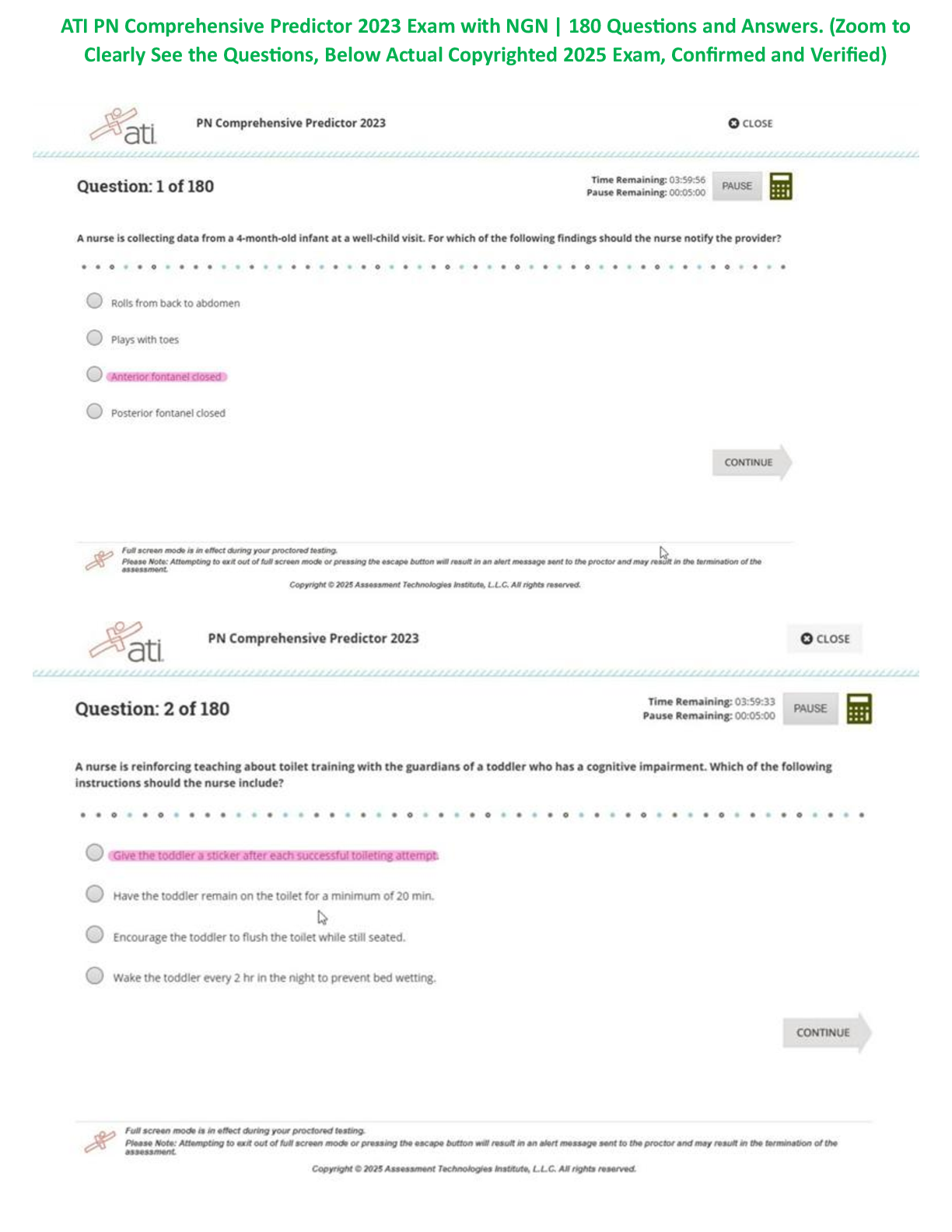NR 222 - Week 5 Assignment Questions and Answers Latest,100% CORRECT
Document Content and Description Below
NR 222 - Week 5 Assignment Questions and Answers Latest Mr. Jonas is admitted to the hospital for fever of unknown origin. He is a 55-year-old patient who has been receiving outpatient dialysis for t ... he past 6 months. He is no longer able to work at the construction job he had for the past 30 years. His wife has recently gone to work part time as a teacher’s aide. Mr. Jonas receives dialysis three times a week and must have someone provide transportation to and from the dialysis center. This is a constant worry for him because his wife has gone back to work. His neighbor takes him to and from the dialysis center and seems happy to have something to do. Mr. Jonas has difficulty hearing but does not consistently wear his hearing aid. When he forgets to wear the hearing aid, he tends to talk loudly to everyone, which is annoying to his wife. This morning, Mr. and Mrs. Jonas are sitting in his room after finishing breakfast. Lucy, a first-year student nurse who is assigned to Mr. Jonas, enters his room and introduces herself. 1. Lucy wants to start her clinical experience positively with Mr. Jonas. How should she address him? A. My name is Lucy, and who are you? B. Hello Bill, I am your student nurse today. C. Good morning, Mr. Jonas. I am Lucy, your student nurse for the morning. D. Hello, Mr. and Mrs. Jonas. How are you today? Answer Rationale It’s important to show respect to the patient, by acknowledging them and making it know who you are. 2. Lucy asks Mr. Jonas if he is finished with his breakfast and notices that he has not eaten any of it and looks pensive. What is the best way to find out more about his nonverbal cues? Answer: Lucy can ask Mr. Jonas if he's having any pain, look for any nonverbal cues, for example, body language, posture, and tone of voice, while you're asking the question and Mr. Jonas response. Rationale Asking the patient if he is pain is a start to figuring out why Mr. Jones isn’t eating. Looking for signs, could tell the reason or put the nurse in a direction of figuring it out. 3. Mr. Jonas does not have his hearing aid in while Lucy is caring for him. What are the best techniques to communicate with someone with this special need? (Select all that apply.) A. Shouting B. Speaking clearly C. Looking directly at him D. Reducing environmental noise E. Talking as she moves about the room Answer Rationale: These techniques are used to have a clear communication with the patient, it lets the patient know that they have the nurse’s full attention. 4. Mr. Jonas starts to cry and says that he feels he is such a burden to everyone since he has been on dialysis. What initial responses from Lucy would indicate that she understands the use of therapeutic techniques? Answer Two therapeutic techniques that would indicate that Lucy understands would be: 1. active listening 2. conveying acceptance. - Lucy maintaining eye contact, showing empathy, nodding appropriately, and being non- judgmental are different kinds of examples that are showing - Lucy is active listening and conveying acceptance. Rationale: These therapeutic techniques show the patient that they have your undivided attention. II. Jared Jones is a nurse who works in a rural long-term care facility. Jared believes that one of the most important aspects of his work is to foster a therapeutic relationship with his clients. Jared does this by using effective communication techniques. Many of Jared’s clients have altered sensory perception such as blindness and deafness. Because of these conditions, Jared has to be extremely patient with his clients. Jared also finds that the use of respect and humor help him bond more readily with his clients. 1. A client says to Jared, “I’m so scared all of the time. I never imagined that I would lose my sight and have to learn to live without seeing things around me.” This client is displaying which aspect of self-awareness? A. Emotional understanding B. Listening C. Self-disclosure D. Practical reflection Rationale: Self-disclosure is the sharing of aspects of the self to enrich one's personal life. Self- disclosure allows one to know himself or herself better by holding thoughts, actions, and feelings up to the light for examination with others 2. Jared communicates with a deaf client by using sign language. Sign language is which type of communication technique? (Select all that apply.) A. Verbal B. Nonverbal C. Metacommunication D. Group process E. Feedback Rationale: Sign language involves nonverbal communication because, although it uses symbols that are communicated through specific signs, these are enhanced by facial expressions and body postures. 3. The communication technique flexibility is a balance between control and permissiveness. Rationale: Flexibility is imperative in providing clear communication. 4. It is important to Jared that his clients trust him. Strategies that promote trust include which of the following? (Select all that apply.) A. Being unpredictable B. Being on time C. Ignoring behaviors that interfere with trust D. Knowing and believing the individual will do as promised E. Clearly defining the relationship parameters and expectations Rationale: Strategies that promote trust include being consistent, examining behaviors that interfere with trust, trusting the individual to do as promised, and clearly defining the relationship parameters and expectations, particularly the purpose and specifics of time, place, and anticipated behavior. III. 1. When working with an older adult who is hearing-impaired, the use of which techniques would improve communication? (Select all that apply.) 1. Check for needed adaptive equipment. 2. Exaggerate lip movements to help the patient lip-read. 3. Give the patient time to respond to questions. 4. Keep communication short and to the point. 5. Communicate only through written information. 2. Nurses must communicate effectively with the health care team for which of the following reasons? (Select all that apply.) 1. To improve the nurse’s status with the health team members 2. To reduce the risk of errors to the patient 3. To provide an optimum level of patient care 4. To improve patient outcomes 5. To prevent issues that need to be reported to outside agencies 3. Motivational interviewing (MI) is a technique that applies understanding a patient’s values and goals in helping the patient make behavioral changes. When using motivational interviewing, what outcomes does the nurse expect? (Select all that apply.) 1. Gaining an understanding of the patient’s motivations 2. Directing the patient to avoid poor health choices 3. Recognizing the patient’s strengths and supporting his or her efforts 4. Providing assessment data that can be shared with families to promote change 5. Identifying differences in patient’s health goals and current behaviors 4. The nurse therapeutically responds to an adult patient who is anxious by: (Select all that apply.) 1. Matching the rate of speech to be the same as that of the patient 2. Providing good eye contact 3. Demonstrating a calm presence 4. Spending time attentively with the patient 5. Assuring the patient that all will be well 5. A nurse prepares to contact a patient’s physician about a change in the patient’s condition. Put the following statements in the correct order using SBAR (Situation, Background, Assessment, and Recommendation) communication. (B)1. “She is a 53-year-old female who was admitted 2 days ago with pneumonia and was started on levofloxacin at 5 PM yesterday. She states she has a poor appetite; her weight has remained stable over the past 2 days.” (A)2. “The patient reported feeling very nauseated after her dose of levofloxacin an hour ago.” 340 (R) 3. “Is it possible to make a change in antibiotics, or could we give her a nutritional supplement before her medication?” (S) 4. “The patient started to complain of nausea yesterday evening and has vomited several times during the night.” 6. The patient states, “I don’t have confidence in my doctor. She looks so young.” The nurse therapeutically responds: (Select all that apply.) 1. Tell me more about your concern. 2. You have nothing to worry about. Your doctor is perfectly competent. 3. You are worried about your care? 4. You can go online and see how others have rated your doctor. I do that. 5. You should ask your doctor to tell you her background. 7. The nurse applying effective communication skills throughout the nursing process should: (Place the following interventions in the correct order.) (2.)1. Validate health care needs through verbal discussion with the patient. (4.)2. Compare actual and expected patient care outcomes with the patient. (3.)3. Provide support through therapeutic communication techniques. (1.)4. Complete a nursing history using verbal communication techniques. 8. A nurse works with a patient using therapeutic communication and the phases of the therapeutic relationship. Place the nurse’s statements in order according to these phases. 2. The nurse is mindful of his/her own biases and knowledge in working with the patient with B12 deficiency. 4. After providing introductions, the nurse defines the scope and purpose of the nurse-patient relationship. 1. The nurse states, “Let’s work on learning injection techniques.” 3. The nurse summarizes progress made during the nursing relationship. 9. Which strategies should a nurse use to facilitate a safe transition of care during a patient’s transfer from the hospital to a skilled nursing facility? (Select all that apply.) 1. Collaboration between staff members from sending and receiving departments 2. Requiring that the patient visit the facility before a transfer is arranged 3. Using a standardized transfer policy and transfer tool 4. Arranging all patient transfers during the same time each day 5. Relying on family members to share information with the new facility 10. The nurse uses silence as a therapeutic communication technique. What are the purposes of the nurse’s silence? (Select all that apply.) 1. Allows the nurse time to focus and avoid saying the wrong thing 2. Prompts the patient to talk when he or she is ready 3. Allows the patient time to think and gain insight 4. Allows time for the patient to drift off to sleep 5. Determines whether the patient would prefer to talk with another staff member [Show More]
Last updated: 3 years ago
Preview 1 out of 11 pages
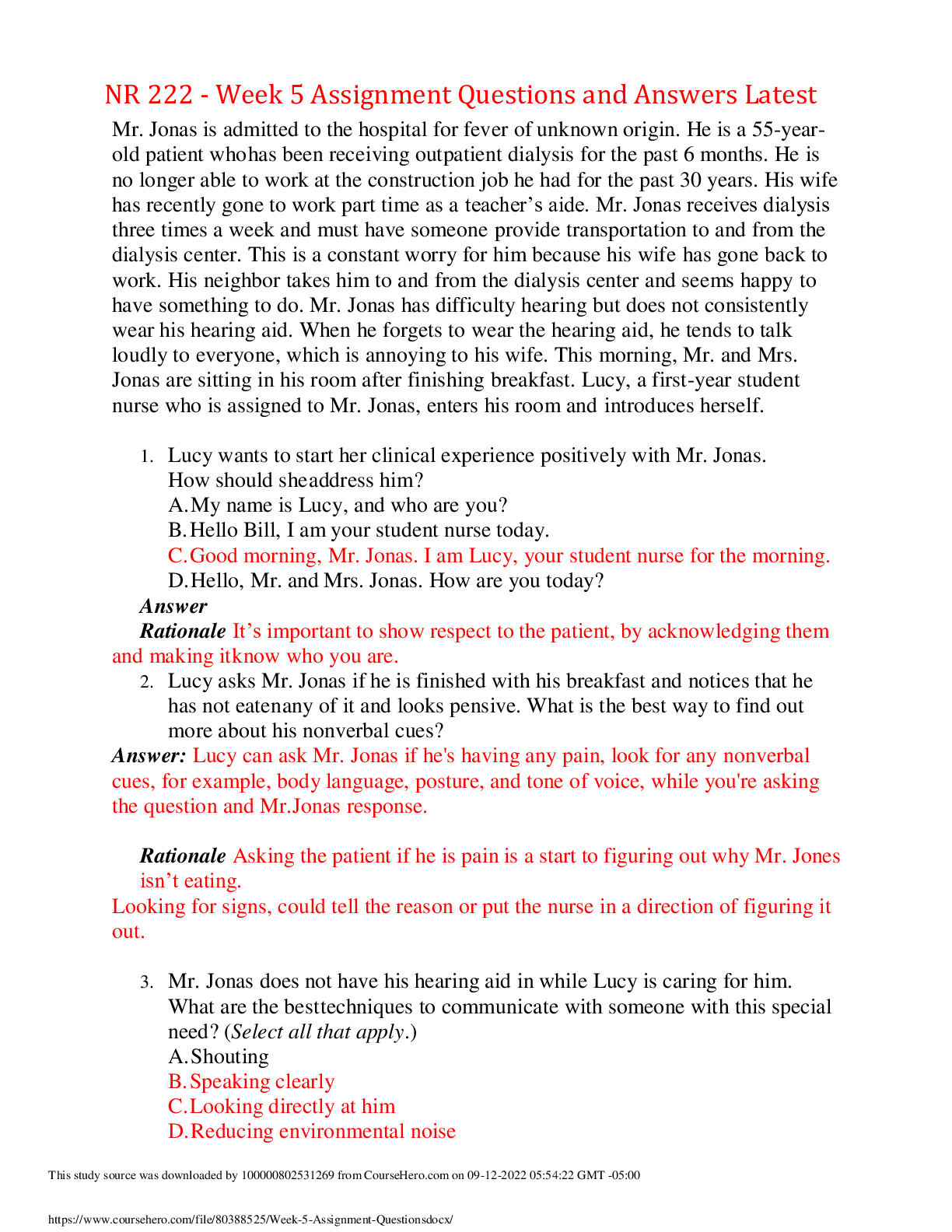
Buy this document to get the full access instantly
Instant Download Access after purchase
Buy NowInstant download
We Accept:

Reviews( 0 )
$15.00
Can't find what you want? Try our AI powered Search
Document information
Connected school, study & course
About the document
Uploaded On
Sep 12, 2022
Number of pages
11
Written in
All
Additional information
This document has been written for:
Uploaded
Sep 12, 2022
Downloads
0
Views
105



